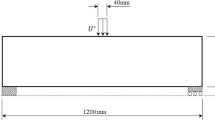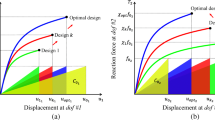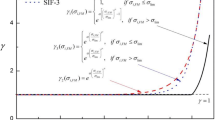Abstract
Conventionally, topology optimisation is formulated as a non-linear optimisation problem, where the material is distributed in a manner which maximises the stiffness of the structure. Due to the nature of non-linear, non-convex optimisation problems, a multitude of local optima will exist and the solution will depend on the starting point. Moreover, while stress is an essential consideration in topology optimisation, accounting for the stress locally requires a large number of constraints to be considered in the optimisation problem; therefore, global methods are often deployed to alleviate this with less control of the stress field as a consequence. In the present work, a strength-based formulation with stress-based elements is introduced for plastic isotropic von Mises materials. The formulation results in a convex optimisation problem which ensures that any local optimum is the global optimum, and the problems can be solved efficiently using interior point methods. Four plane stress elements are introduced and several examples illustrate the strength of the convex stress-based formulation including mesh independence, rapid convergence and near-linear time complexity.














Similar content being viewed by others
References
Anderheggen E, Knöpfel H (1972) Finite element limit analysis using linear programming. Int J Solids Struct 8:1413–1431
Andersen ED, Roos C, Terlaky T (2003) On implementing a primal-dual interior-point method for conic quadratic optimization. Math Program 95(2):249–277
Bendsøe MP (1995) Optimization of structural topology, shape, and material, vol 414. Springer, Berlin
Bendsøe MP, Kikuchi N (1988) Generating optimal topologies in structural design using a homogenization method. Comput Methods Appl Mech Eng 71(2):197–224
Bendsøe MP, Sigmund O (2003) Topology optimization: theory, methods and applications. Springer, Berlin
Bisbos C, Pardalos P (2007) Second-order cone and semidefinite representations of material failure criteria. J Optim Theory Appl 134(2):275–301
Borges LA, Zouain N, Huespe AE (1996) A nonlinear optimization procedure for limit analysis. Eur J Mech Ser A Solids 15:487–512
Boyd S, Vandenberghe L (2004) Convex optimization. Cambridge University Press, Cambridge
Bruggi M, Duysinx P (2013) A stress–based approach to the optimal design of structures with unilateral behavior of material or supports. Struct Multidiscip Optim 48(2):311–326
Deaton JD, Grandhi RV (2014) A survey of structural and multidisciplinary continuum topology optimization: post 2000. Struct Multidiscip Optim 49(1):1–38
Dorn WS, Gomory RE, Greenberg HJ (1964) Automatic design of optimal structures. J Mecanique 3:25–52
Duysinx P, Sigmund O (1998) New developments in handling stress constraints in optimal material distribution. In: Proceedings of the 7th AIAA/USAF/NASAISSMO symposium on multidisciplinary analysis and optimization, vol 1, pp 1501–1509
Duysinx P, Van Miegroet L, Lemaire E, Brüls O, Bruyneel M (2008) Topology and generalized shape optimization: why stress constraints are so important? Int J Simul Multidiscip Des Optim 2(4):253–258
Engwirda D (2014) Locally optimal delaunay-refinement and optimisation-based mesh generation. Ph.D. thesis. University of Sydney
Haftka RT, Grandhi RV (1986) Structural shape optimization—a survey. Comput Methods Appl Mech Eng 57(1):91–106
Hegemier G, Prager W (1969) On Michell trusses. Int J Mech Sci 11(2):209–215
Herfelt MA, Poulsen PN, Hoang LC, Jensen JF (2017) Lower bound equilibrium element and submodel for shear joints in precast concrete structures. Eng Struct 135:1–9
Kammoun Z, Smaoui H (2014) A direct approach for continuous topology optimization subject to admissible loading. C R Mec 342(9):520–531
Karmarkar N (1984) A new polynomial-time algorithm for linear programming. Combinatorica 4:373–395
Kohn RV, Strang G (1986) Optimal design and relaxation of variational problems, i. Commun Pure Appl Math 39(1):113–137
Krabbenhøft K (2016) Shell finite element. Optum Computational Engineering
Krabbenhøft K, Lyamin A, Sloan S (2007) Formulation and solution of some plasticity problems as conic programs. Int J Solids Struct 44(5):1533–1549
Lobo MS, Vandenberghe L, Boyd S, Lebret H (1998) Applications of second-order cone programming. Linear Algebra Appl 284(1):193–228
Lyamin AV, Sloan SW (2002) Upper bound limit analysis using linear finite elements and non-linear programming. Int J Numer Anal Methods Geomech 26(2):181–216
Makrodimopoulos A, Martin C (2006) Lower bound limit analysis of cohesive-frictional materials using second-order cone programming. Int J Numer Methods Eng 66(4):604–634
Makrodimopoulos A, Martin C (2007) Upper bound limit analysis using simplex strain elements and second-order cone programming. Int J Numer Anal Methods Geomech 31(6):835–865
Michell AGM (1904) Lviii. The limits of economy of material in frame-structures. Lond Edinb Dublin Philos Mag J Sci 8(47):589–597
MOSEK ApS: MOSEK MATLAB toolbox. Release 8.0.0.81 (2017). Available at https://www.mosek.com/
Nemhauser GL, Wolsey LA (1992) Integer programming and combinatorial optimization. Wiley, Chichester
Nemhauser GL, Savelsbergh M W P, Sigismondi G S (1988) Constraint classification for mixed integer programming formulations. COAL Bull 20:8–12
Nesterov Y, Nemirovsky A (1988) A general approach to polynomial-time algorithms design for convex programming. Report, Central Economical and Mathematical Institute, USSR Academy of Sciences, Moscow
Olhoff N, Taylor J (1983) On structural optimization. J Appl Mech 50(4b):1139–1151
Pedersen P (1998) Some general optimal design results using anisotropic, power law nonlinear elasticity. Struct Optim 15(2):73–80
Poulsen PN, Damkilde L (2000) Limit state analysis of reinforced concrete plates subjected to in-plane forces. Int J Solids Struct 37:6011–6029
Prager W, Rozvany G (1977a) Optimal layout of grillages. J Struct Mech 5(1):1–18
Prager W, Rozvany GI (1977b) Optimization of structural geometry. In: Dynamical systems. Elsevier, pp 265–293
Prager W, Shield R (1967) A general theory of optimal plastic design. J Appl Mech 34(1):184–186
Prager W, Taylor JE (1968) Problems of optimal structural design. J Appl Mech 35(1):102–106
Rozvany GI, Prager W (1979) A new class of structural optimization problems: optimal archgrids. Comput Methods Appl Mech Eng 19(1):127–150
Rozvany GI, Zhou M, Birker T (1992) Generalized shape optimization without homogenization. Struct Optim 4(3-4):250–252
Sigmund O (2001) A 99 line topology optimization code written in matlab. Struct Multidiscip Optim 21 (2):120–127
Sigmund O, Petersson J (1998) Numerical instabilities in topology optimization: a survey on procedures dealing with checkerboards, mesh-dependencies and local minima. Struct Optim 16(1):68–75
Sloan SW (1988) Lower bound limit analysis using finite elements and linear programming. Int J Numer Anal Methods Geomech 12:61–77
Sloan SW (1989) Upper bound limit analysis using finite elements and linear programming. Int J Numer Anal Methods Geomech 13:263–282
Svanberg K (1987) The method of moving asymptotes—a new method for structural optimization. Int J Numer Methods Eng 24(2):359–373
Terlaky T (2013) Interior point methods of mathematical programming, vol 5. Springer Science & Business Media
Funding
The authors received financial support from the ALECTIA Foundation and Innovation Fund Denmark.
Author information
Authors and Affiliations
Corresponding author
Additional information
Responsible Editor: Anton Evgrafov
Publisher’s Note
Springer Nature remains neutral with regard to jurisdictional claims in published maps and institutional affiliations.
Appendices
Appendix A: Equilibrium matrices for the plane stress elements
1.1 A.1 The Zouain element
1.2 A.2 Standard six-node element
1.3 A.3 Upper bound element
Appendix B: Tabulated results
Rights and permissions
About this article
Cite this article
Herfelt, M.A., Poulsen, P.N. & Hoang, L.C. Strength-based topology optimisation of plastic isotropic von Mises materials. Struct Multidisc Optim 59, 893–906 (2019). https://doi.org/10.1007/s00158-018-2108-y
Received:
Revised:
Accepted:
Published:
Issue Date:
DOI: https://doi.org/10.1007/s00158-018-2108-y




